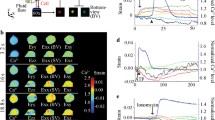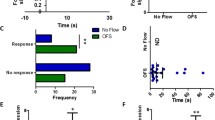Abstract
Mechanical forces trigger biological responses in bone cells that ultimately control osteoblastogenesis and bone program. Although several mechanosensors have been postulated, the precise mechanotransduction pathway remains obscure as the initial mechanosensing event has not yet been identified. Studies in kidney cells have shown that polycystin-1 (PC1), via its extracellular N-terminal part, may function as an “antenna-like” protein providing a linkage between environmental cues and their conversion into biochemical responses that regulate various cellular processes via the calcineurin/NFAT pathway. Here we explored the involvement of PC1 in mechanical load (stretching)-induced signaling cascades that control osteoblastogenesis/bone formation. FACS and TransAM Transcription Factor ELISA analyses employing extracts from primary human osteoblast-like, PC1 expressing cells subjected to mechanical stretching (0–6 h) revealed that unphosphorylated/DNA-binding competent NFATc1 increased at 0.5–1 h and returned to normal at 6 h. In accordance with the activation mechanism of NFATc1, stretching of cultured cells pre-treated with cyclosporin A (CsA, a specific inhibitor of the calcineurin/NFAT pathway) abrogated the observed decrease in the abundance of the cytoplasmic pNFATc1 (phosphorylated/inactive) species. Furthermore, stretching of osteoblastic cells pre-treated with an antibody against the mechanosensing N-terminal part of PC1 also abrogated the observed decrease in the cytoplasmic levels of the inactive pNFATc1 species. Importantly, under similar conditions (pre-incubation of stretched cells with the inhibitory anti-PC1 antibody), the expression of the key osteoblastic, NFATc1-target gene runx2 decreased compared to untreated cells. Therefore, PC1 acts as chief mechanosensing molecule that modulates osteoblastic gene transcription and hence bone-cell differentiation through the calcineurin/NFAT signaling cascade.







Similar content being viewed by others
Abbreviations
- ADPKD:
-
Autosomal dominant polycystic kidney disease
- CsA:
-
Cyclosporin A
- FACS:
-
Fluorescent-activated cell sorting
- hPDL cells:
-
Human periodontal ligament cells
- NFAT:
-
Nuclear factor of activated T cells
- NFATc1:
-
Nuclear factor of activated T cells, cytoplasmic 1
- PC1:
-
Polycystin-1
- PC2:
-
Polycystin-2
- Pkd ½ :
-
Polycystic kidney disease 1/2 (polycystin 1/2) gene
- pNFAT:
-
Phosphorylated nuclear factor of activated T cells
- Runx2:
-
Runt-related transcription factor 2
References
Chen JH, Liu C, You L, Simmons CA (2010) Boning up on Wolff’s law: mechanical regulation of the cells that make and maintain bone. J Biomech 43:108–118
Marie PJ (2008) Transcription factors controlling osteoblastogenesis. Arch Biochem Biophys 473:98–105
Papachristou DJ, Papachroni KK, Basdra EK, Papavassiliou AG (2009) Signaling networks and transcription factors regulating mechanotransduction in bone. BioEssays 31:794–804
Papachroni KK, Karatzas DN, Papavassiliou KA, Basdra EK, Papavassiliou AG (2009) Mechanotransduction in osteoblast regulation and bone disease. Trends Mol Med 15:208–216
Chien MY, Wu YT, Hsu AT, Yang RS, Lai JS (2000) Efficacy of a 24-week aerobic exercise programme for osteopenic postmenopausal women. Calcif Tissue Int 67:443–448
Iwamoto J, Takeda T, Ichimura S (2001) Effect of exercise training and detraining on bone mineral density in postmenopausal women with osteoporosis. J Orthop Sci 6:128–132
Sinaki M, Brey RH, Hughes CA, Larson DR, Kaufman KR (2005) Significant reduction in risk of falls and back pain in osteoporotic-kyphotic women through a Spinal Proprioceptive Extension Exercise Dynamic (SPEED) Programme. Mayo Clin Proc 80:849–855
Kemmler W, Lauber D, Weineck J, Hensen J, Kalender W, Engelke K (2004) Benefits of 2 years of intense exercise on bone density, physical fitness, and blood lipids in early postmenopausal osteopenic women: results of the Erlangen Fitness Osteoporosis Prevention Study (EFOPS). Arch Intern Med 164:1084–1091
Todd JA, Robinson RJ (2003) Osteoporosis and exercise. Postgrad Med J 79:320–323
Basdra EK, Papavassiliou AG, Huber LA (1995) Rab and rho GTPases are involved in specific response of periodontal ligament fibroblasts to mechanical stretching. Biochim Biophys Acta 1268:209–213
Basdra EK, Komposch G (1997) Osteoblast-like properties of human periodontal ligament cells: an in vitro analysis. Eur J Orthod 19:615–621
Kletsas D, Basdra EK, Papavassiliou AG (1998) Mechanical stress induces DNA synthesis in PDL fibroblasts by a mechanism unrelated to autocrine growth factor action. FEBS Lett 430:358–362
Peverali FA, Basdra EK, Papavassiliou AG (2001) Stretch-mediated activation of selective MAPK subtypes and potentiation of AP-1 binding in human osteoblastic cells. Mol Med 7:68–78
Ziros PG, Gil AP, Georgakopoulos T, Habeos I, Kletsas D, Basdra EK, Papavassiliou AG (2002) The bone-specific transcriptional regulator Cbfa1 is a target of mechanical signals in osteoblastic cells. J Biol Chem 277:23934–23941
Yousefian JZ, Ngan PW, Miller B, Shanfeld J, Davidovitch Z (1992) Effect of different types of stress on human periodontal ligament cells in vitro. In: Davidovitch Z (ed) Biological mechanisms of tooth movement and craniofacial adaptation. The Ohio State University, College of Dentistry, Colombus, pp 319–329
Naruse K, Sokabe M (1993) Involvement of stretch-activated ion channels in Ca2+ mobilisation to mechanical stretch in endothelial cells. Am J Physiol 264:C1037–C1044
Ziros PG, Basdra EK, Papavassiliou AG (2008) Runx2: of bone and stretch. Int J Biochem Cell Biol 40:1659–1663
Reeders ST, Breuning MH, Davies KE, Nicholls RD, Jarman AP, Higgs DR, Pearson PL, Weatherall DJ (1985) A highly polymorphic DNA marker linked to adult polycystic kidney disease on chromosome 16. Nature 317:542–544
Zhou J (2009) Polycystins and primary cilia: primers for cell cycle progression. Annu Rev Physiol 71:83–113
Dalagiorgou G, Basdra EK, Papavassiliou AG (2010) Polycystin-1: function as a mechanosensor. Int J Biochem Cell Biol 42:1610–1613
Xiao Z, Zhang S, Mahlios J, Zhou G, Magenheimer BS, Guo D, Dallas SL, Maser R, Calvet JP, Bonewald L, Quarles LD (2006) Cilia-like structures and polycystin-1 in osteoblasts/osteocytes and associated abnormalities in skeletogenesis and Runx2 expression. J Biol Chem 281:30884–30895
Xiao Z, Zhang S, Magenheimer BS, Luo J, Quarles LD (2008) Polycystin-1 regulates skeletogenesis through stimulation of the osteoblast-specific transcription factor RUNX2-II. J Biol Chem 283:12624–12634
Hou B, Kolpakova-Hart E, Fukai N, Wu K, Olsen BR (2009) The polycystic kidney disease 1 (Pkd1) gene is required for the responses of osteochondroprogenitor cells to midpalatal suture expansion in mice. Bone 44:1121–1133
Hanaoka K, Qian F, Boletta A, Bhunia AK, Piontek K, Tsiokas L, Sukhatme VP, Guggino WB, Germino GG (2000) Co-assembly of polycystin-1 and -2 produces unique cation-permeable currents. Nature 408:990–994
Gonzalez-Perrett S, Kim K, Ibarra C, Damiano AE, Zotta E, Batelli M, Harris PC, Reisin IL, Arnaout MA, Cantiello HF (2001) Polycystin-2, the protein mutated in autosomal dominant polycystic kidney disease (ADPKD), is a Ca2+-permeable nonselective cation channel. Proc Natl Acad Sci USA 98:1182–1187
Koulen P, Cai Y, Geng L, Maeda Y, Nishimura S, Witzgall R, Ehrlich BE, Somlo S (2002) Polycystin-2 is an intracellular calcium release channel. Nat Cell Biol 4:191–197
Nauli SM, Alenghat FJ, Luo Y, Williams E, Vassilev P, Li X, Elia AE, Lu W, Brown EM, Quinn SJ, Ingber DE, Zhou J (2003) Polycystins 1 and 2 mediate mechanosensation in the primary cilium of kidney cells. J Nat Genet 33:129–137
Rao A, Luo C, Hogan PG (1997) Transcription factors of the NFAT family: regulation and function. Annu Rev Immunol 15:707–747
Flanagan WM, Corthesy B, Bram RJ, Crabtree GR (1991) Nuclear association of a T-cell transcription factor blocked by FK-506 and cyclosporine A. Nature 352:803–807
Zayzafoon M (2006) Calcium/calmodulin signaling controls osteoblast growth and differentiation. J Cell Biochem 97:56–70
Puri S, Magenheimer BS, Maser RL, Ryan EM, Zien CA, Walker DD, Wallace DP, Hempson SJ, Calvet JP (2004) Polycystin-1 activates the calcineurin/NFAT (nuclear factor of activated T-cells) signaling pathway. J Biol Chem 53:55455–55564
Qian F, Boletta A, Bhunia AK, Xu H, Liu L, Ahrabi AK, Watnick TJ, Zhou F, Germino GG (2002) Cleavage of polycystin-1 requires the receptor for egg jelly domain and is disrupted by human autosomal-dominant polycystic kidney disease 1-associated mutations. Proc Natl Acad Sci USA 99:16981–16986
Ibraghimov-Beskrovnaya O, Bukanov NO, Donohue LC, Dackowski WR, Klinger KW, Landes GM (2000) Strong homophilic interactions of the Ig like domains of polycystin-1, the protein product of an autosomal dominant polycystic kidney disease gene, PKD1. Hum Mol Genet 9:1641–1649
Streets AJ, Wagner BE, Harris PC, Ward CJ, Ong AC (2009) Homophilic and heterophilic polycystin 1 interactions regulate E-cadherin recruitment and junction assembly in MDCK cells. J Cell Sci 122:1410–1417
Marais R, Wynne J, Treisman R (1993) The SRF accessory protein Elk-1 contains a growth factor-regulated transcriptional activation domain. Cell 73:381–393
Schreiber E, Matthias P, Muller MM, Schaffner W (1989) Rapid detection of octamer binding proteins with ‘min-extracts’, prepared from a small number of cells. Nucleic Acids Res 17:6419
Fujii S, Maeda H, Wada N, kano Y, Akamine A (2006) Establishing and characterizing human periodontal ligament fibroblasts immortalized by SV40T-antigen and hTERT gene transfer. Cell Tissue Res 324:117–125
Farmaki E, Mkrtchian S, Papazian I, Papavassiliou AG, Kiaris H (2011) ERp29 regulates response to doxorubicin by a PERK-mediated mechanism. Biochim Biophys Acta 1813:1165–1171
Yeo H, Beck LH, McDonald JM, Zayzafoon M (2007) Cyclosporin A elicits dose-dependent biphasic effects on osteoblast differentiation and bone formation. Bone 40:1502–1516
Penolazzi L, Lisignoli G, lambertini E, Torreggiani E, Manferdini C, Lolli A, Vecchiatini R, Ciardo F, Gabusi E, Facchini A, Gambari R, Piva R (2011) Transcription factor decoy against NFATc1 in human primary osteoblasts. Int J Mol Med 28:199–206
Kolpakova-Hart E, McBratney-Owen B, Hou B, Fukai N, Nicolae C, Zhou J, Olsen BR (2008) Growth of cranial synchondroses and sutures requires polycystin-1. Dev Biol 321:407–419
Aguiari G, Trimi V, Bogo M, Magnolini A, Szabadkai G, Pinton P, Witzgall R, Harris PC, Borea PA, Del Senno L (2008) Novel role of polycystin-1 in modulating cell proliferation trough calcium oscillations in kidney cells. Cell Prolif 41:554–573
Acknowledgments
We are grateful to Dr. G.G. Germino for the anti-CT antibody and the stably transfected MDCK-PKD1 cell line. We thank Dr. Oxana Ibraghimov-Beskrovnaya for the inhibitory anti-Ig-PKD1 antibody.
Author information
Authors and Affiliations
Corresponding author
Additional information
G. Dalagiorgou and C. Piperi contributed equally to this study.
Rights and permissions
About this article
Cite this article
Dalagiorgou, G., Piperi, C., Georgopoulou, U. et al. Mechanical stimulation of polycystin-1 induces human osteoblastic gene expression via potentiation of the calcineurin/NFAT signaling axis. Cell. Mol. Life Sci. 70, 167–180 (2013). https://doi.org/10.1007/s00018-012-1164-5
Received:
Revised:
Accepted:
Published:
Issue Date:
DOI: https://doi.org/10.1007/s00018-012-1164-5




